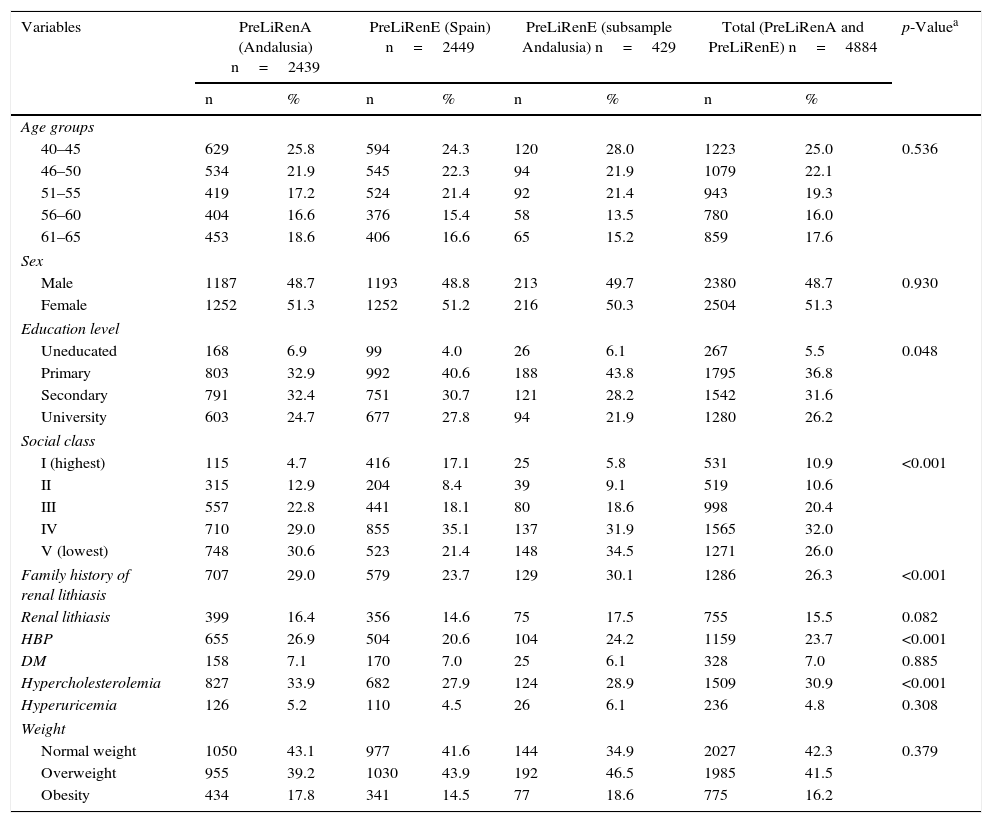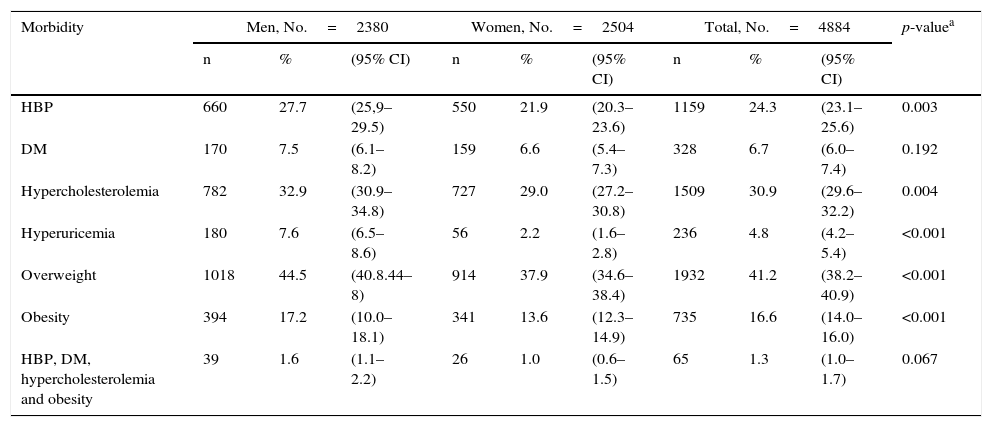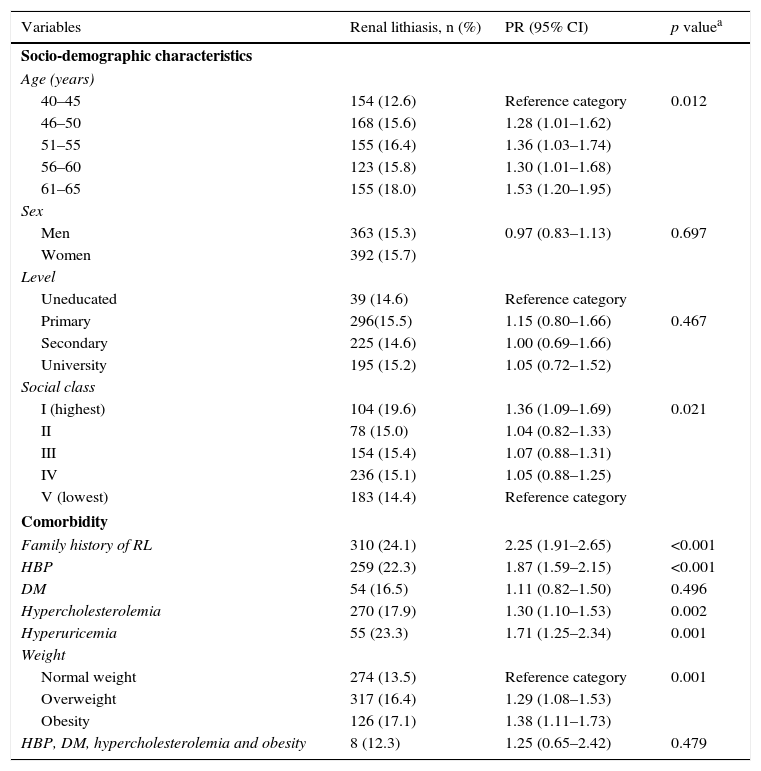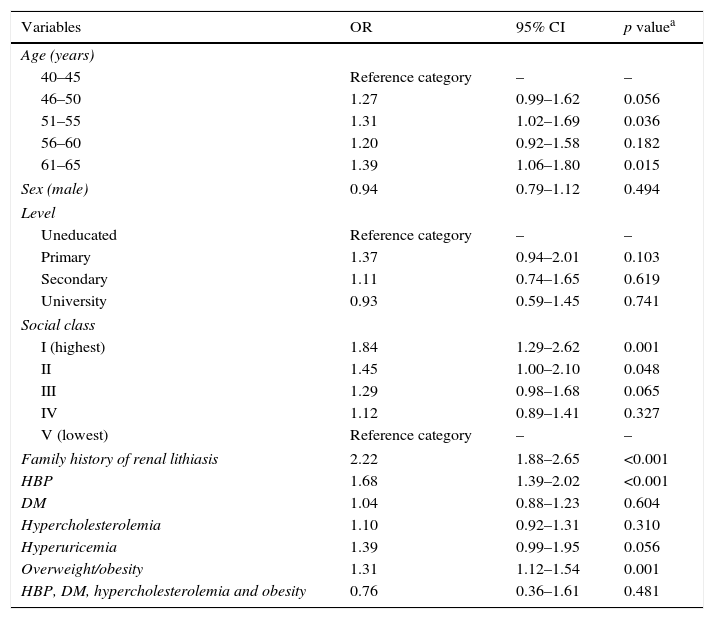Renal lithiasis is one of the most important urological diseases. It seems to be related to different socio-demographic and climatic factors, lifestyle and pre-existing comorbidity. The aim of this study was to examine the relationship between socio-demographic variables, certain risk factors and chronic diseases and the renal lithiasis.
Patients and methodA cross-sectional population-based study was carried out, selecting the Spanish population aged from 40 to 65 years, combining 2 random samples (PreLiRenA and PreLiRenE studies). Data were collected by personal telephone surveys, gathering information on socio-demographic variables and perceived morbidity. Data on annual average temperatures in each Spanish region were also collected. A bivariate and multivariate analysis was performed.
ResultsA total of 4894 subjects were surveyed; 51.3% were women; 25% were aged 40–45 years, 36% had primary school education and 31.4% were of low social class. The overall prevalence of renal lithiasis was 15.0% (95% confidence interval [95% CI] 14.5–15.5). By means of multivariate analysis, the variables that showed a strong statistical relationship with the presence of renal lithiasis were: older age (61–65 years; OR=1.39; 95% CI 1.06–1.80), high social class (OR=1.98; 95% CI 1.29–2.62), family history of renal lithiasis (OR=2.22; 95% CI 1.88–2.65), high blood pressure (OR=1.68; 95% CI 1.39–2.02) and overweight/obesity (OR=1.31; 95% CI 1.12–1.54). A correlation was observed between renal lithiasis and average annual temperatures in the Spanish regions (r=0.59; p=0.013).
ConclusionsA relationship was observed between renal lithiasis and older age, belonging to higher social classes, the existence of a family history of urolithiasis, and hypertension and overweight or obesity. The prevalence of renal lithiasis is greater in warmer climate zones.
La litiasis renal es una de las enfermedades urológicas más importantes. Parece estar relacionada con factores sociodemográficos y climáticos, estilos de vida y comorbilidad preexistente. El objetivo de este trabajo fue examinar la relación entre variables sociodemográficas, ciertos factores de riesgo y enfermedades crónicas, y la litiasis renal.
Pacientes y métodoSe realizó un estudio transversal, seleccionando a población española de 40 a 65 años, combinando 2 muestras aleatorias (PreLiRenA y PreLiRenE). Los datos fueron recogidos por encuestas telefónicas personales, recopilando información sobre variables sociodemográficas y la morbilidad percibida. También se recogieron datos sobre las temperaturas medias anuales en cada región española. Se realizó un análisis bivariado y multivariado.
ResultadosFueron encuestados 4.894 sujetos; el 51,3% eran mujeres; el 25% tenían entre 40 y 45 años; el 36% tenían educación primaria y el 31,4% eran de clase social baja. La prevalencia global de litiasis renal fue del 15,0% (intervalo de confianza al 95% [IC 95%] 14,5–15,5). Por medio del análisis multivariado, las variables que mostraron una fuerte relación estadística con la presencia de litiasis renal fueron: edad avanzada (61-65 años, OR=1,39; IC 95% 1,06-1,8), clase social alta (OR=1,98; IC 95% 1,29-2,62), antecedentes familiares de litiasis renal (OR=2,22; IC 95% 1,88-2,65), hipertensión arterial (OR=1,68; IC 95% 1,39-2,02) y sobrepeso/obesidad (OR=1,31; IC 95% 1,12-1,54). Se observó una correlación entre la litiasis renal y las temperaturas medias anuales en las regiones españolas (r=0,59; p=0,013).
ConclusionesExiste relación entre litiasis renal y edad avanzada, pertenecer a clases sociales altas, existencia de antecedentes familiares de urolitiasis, y tener hipertensión y sobrepeso/obesidad. La prevalencia de la litiasis renal es mayor en las zonas climáticas más cálidas.
Artículo
Comprando el artículo el PDF del mismo podrá ser descargado
Precio 19,34 €
Comprar ahora











